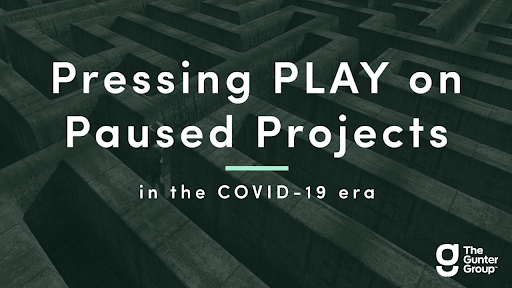Since March, the COVID-19 pandemic has changed the way we work, the way we live, and the way we interact with the world. To cope with these widespread changes, organizations have had to make tough choices and “hit the pause button”, delaying projects and strategic initiatives.
We are now seeing enterprises reinstating their paused projects and initiatives, but in a changed world where challenges such as limited and/or remote staff, constrained budgets, and emerging competing priorities need to be factored into the mix. Organizations need to relaunch project work in a strategic way that accounts for today’s ever-changing business climate as well as the increased pressure employees are facing while navigating the complex COVID era.
Before deciding to restart a project, consider the following questions:
1. Are there environmental, emotional, or other considerations that should be taken into account before kicking off this project again?
2. Is the project still relevant and does it represent a productive use of time?
3. Staffing levels may have been impacted. Team members may be overwhelmed with competing priorities. Does the organization have adequate staffing and resourcing for this project or is there a need to secure outside assistance to support internal staff?
4. Does this project provide clear benefits regardless of possible uncertainty in the future?
5. Are there risks and costs to the organization by further delaying the project?
Strategies for moving forward
Applying a comprehensive strategic framework to think through the complex logistical, financial, and human components of the project can help an organization ensure multiple angles have been considered before moving forward with stalled projects.
The steps outlined here are relevant for any project initiation, but it’s particularly crucial now to make sure that the organization is fully prepared to launch an initiative in a thoughtful and informed way.

Evaluate and Revise Strategy: As our global situation evolves, public health policies enacted to mitigate the effects of COVID-19 will impact the availability of resources and timing of many projects.
Additionally, it is important to re-evaluate the big questions—those considerations that are less tactical and for which planning is more difficult. How does this project align with the organization’s core values, and are those values changing in response to the impacts of COVID-19?
Lastly, there may be tactical components of the original project strategy that may not be conducive to a COVID-19 environment. For example, brainstorm sessions, project meetings, and testing will likely take place remotely. Timeline and toolset considerations may also need to be adjusted.
Align Stakeholders: Even in the best of times, projects often begin prematurely, before stakeholder alignment is adequately reached. Now more than ever, it is imperative for the success of any reinstated work that stakeholders are informed, aligned, and have a renewed commitment to contribute towards the successful culmination of the project. As appropriate, leaders should seek to foster stakeholder participation and feedback in the prioritization process to align on the purpose of the project and to provide consistent messaging to employees and consumers. Commence replanning efforts by conducting a stakeholder analysis and integrating the findings. Overlooking this vital step could result in major roadblocks and setbacks throughout the remaining life of the project.
Resource Project: The resources originally allocated for the project may now be unavailable, team members may lack required skill sets, or they may not currently have the bandwidth to contribute to another project. Therefore, the need for both external and internal support should be properly assessed.
Recently, McKinsey & Company emphasized the need for leaders to focus on reskilling and upskilling their workforce to deliver new business models in the post-pandemic era. Companies also face a learning curve as managers figure out how to lead their teams virtually, build social capital, and maintain cohesion without the benefit of in-person interactions. As companies contemplate returning to the workplace, a new set of skills is also likely to emerge for the transition.
Sometimes a major reskilling effort isn’t feasible or practical to fill key needs for a project. In this scenario, pulling in outside expertise or resources may be the best option. Consultants are often brought into the fold of a project to fill an experience, knowledge, or skill set gap or even as an extra set of hands for a daunting effort where the organization’s future hiring picture is unclear.
Build Execution Roadmap: As things continue to change, a well developed and clearly communicated execution roadmap will help keep the project team’s eye on the prize. The steps taken so far in restarting the project—updated strategy, aligned and informed stakeholders, and prepared project resources—are the building blocks of an execution roadmap. Identify where it is possible to include flexibility points in an execution strategy. Planning for potential changes to “Plan A” will allow for an easier path forward if additional unexpected changes occur in the life of the project.
Employ Agile Execution Model: There’s no better time than now to embrace an agile methodology. By definition, the agile project management methodology is designed to be collaborative, flexible, and adaptable to change, and the change introduced to organizations by COVID-19 has put it to the ultimate test. Research conducted by McKinsey & Company found that companies with agile practices embedded in their operating models have managed the impact of the COVID-19 crisis better than their non-agile counterparts.

Communicate and Engage the Org: Effective communication and engagement can be challenging, especially given the challenges of physical distance, work-life balance, and a multitude of other distractions. Project details must be communicated to the right people at the right time.
Many organizations are also at the point where employees are hitting conference call and email fatigue. Since the majority of our communications are now limited to back-to-back video calls or an ever-expanding email inbox, communications are at greater risk of being lost in the shuffle.
Fortunately, there are many tools and resources available to help streamline communications in 2020, some of which may already be familiar and some lesser known:
– Facilitation tools (MURAL, retrium, MS Teams, klaxon, miro, STORMZ)
– Communication tools (Skype, Zoom, Google Hangouts)
– Presentations & Meetings (Ideaboardz, Conceptboard, workplace, slack, Google Meet)
– Project Management (Smartsheet, Microsoft Planner, Teamwork, Confluence, Jira, Basecamp, Trello, asana, N)
– Team Building (Kahoot!, TEAM MOOD, Dr. Clue, donut)
– Events (Meetyoo, HEXAFAIR, ENGAGE, VIRTUALIST
Build Rapid Feedback Mechanisms: Integrating feedback loops, both internal and external, into the project’s workflow, such as cadences in the Kanban method, for example, offer a powerful communication tool that fosters efficient and continuous improvement through effective adaptation to the often evolving needs of one’s client. It is valuable to build a mechanism, such as frequent, effective meetings, to facilitate constant and constructive evaluation as a team.
Moving forward with grace
With all the tactical and strategic planning that is needed to evolve an organization or advance a project forward, it is important not to lose sight of the human element. The planning process should be imbued with emotional intelligence, described as the ability to appropriately apply emotion to manage and solve problems—an approach with many tangible and far-reaching benefits within any organization.
In many different ways, it has been a challenging year and people are facing internal and external hurdles that could not have been predicted a year ago. Contributing to a project is a wonderful growth opportunity, gives people a chance to connect with their teammates towards a common goal, and produces tangible results. However, it is more important than ever for leaders to show that they care about their team.
Deeply considering the outcome of new or restarted work on employees and consumers has never been more important. Prioritizing the work ahead should consider not only the immediate benefit to the organization itself but also the benefits of doing right by the people of the organization in the long term.
At The Gunter Group, we can help implement the project leadership and process improvement strategies discussed above. Contact us to learn more about how we can support and optimize your organization.

About the Author:
Kara is a collaborative and detail-oriented consultant specializing in project management, organizational change and strategic communications. She has an ability to jump quickly into complex situations and scenarios, which allows her to understand and deliver on her clients’ key priorities within tight deadlines. Kara is also very skilled at considering issues with a fresh perspective, allowing her to suggest and implement viable solutions that may not have been previously considered by an organization. With a diverse background in communications, marketing analytics, team leadership and project management, Kara has enjoyed bringing strategic solutions to her clients for over 10 years. She has worked in a wide range of industries for many nationally-recognized brands, primarily in the technology, healthcare, sportswear, and early childhood education sectors. Kara holds a B.S in Business Administration and Marketing from Central Washington University. She is also a Certified Scrum Master and PROSCI Certified Change Practitioner. In her free time, Kara enjoys spending time in the great outdoors with her family of four.


